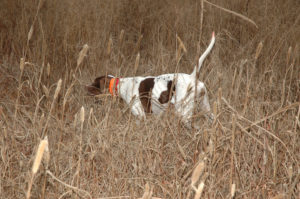I was ruminating on the potency of rattlesnake venom and the mortality rates associated with a strike as I stepped carefully through the wiregrass carpeted pine woods near my southwest Georgia home. After having just found a couple of fresh snake sheds, I was making sure to keep a wary eye. It was then the ground seemed to explode beneath my feet, and my heart nearly burst from chest.
A pair of quail popped from the ground with such a flurry the surprise nearly toppled me over. Had it been a fall covey of 10 or so birds instead of just the two, I might still be sitting there.
Despite the scare, I was thrilled with the encounter. I grew up hunting quail with my dad and brother whenever the chance arrived. The little 6-oz. bird with its distinctive ‘bob- bob white’ call is important to me, as it used to be with many Georgia hunters. The bobwhite quail was so important it was named Georgia’s official state game bird in 1970.
The truth is though, it has been almost 10 years since I’ve swung a shotgun in a quail’s direction. I’m not the only one either, as Georgia has lost more than 75 percent of its quail hunters over the last two decades.
There are many reasons for this, but mostly it revolves around the lack of birds. For decades now quail numbers have been in steep decline, and experts believe this mostly has to do with habitat. Quail need brushy cover and weedy edges to survive. Slicked off farms don’t provide quail anything to eat, and the birds need ground cover that’s neither too thick nor too sparse. Georgia’s increasing urbanization has done the bird no favors either.
Peach Stater hunters are not alone in their lack of quail. According to Jared Wicklund, of Quail Forever, an organization devoted to quail and quail habitat, the decline in quail numbers and the hunters is not just a Georgia issue.
“Nationwide, in 2010-11 quail numbers really bottomed out,” Wicklund said.
He went on to explain that quail are an early successional habitat bird that needs the new growth that comes after a fire to thrive. These birds have high natural mortality rates due to many factors that can range from weather to predators. They balance that by having high reproductive rates, but if there is not good nesting ground, then they quickly become absent from the landscape.
Throughout it all there have always been pockets of excellent quail hunting. Mostly though, this is on plantations managed specifically for quail. These plantations are beautiful huge old tracts of longleaf pine and offer a wonderful experience for the well-heeled hunter, of which I am not. So, like a lot of others, I had to put the shotgun away and give up trying to find a good bird dog, focusing my attention instead on hunting deer and other critters.
Georgia’s Department of Natural Resources long been working to address the quail issue. Recently, I was able to get in contact with Dallas Ingram, a State Wildlife Coordinator with DNR’s Wildlife Resources Division, and I asked her about quail hunting public lands in Georgia. She said they had been working specifically for quail on some WMAs.
When asked for an example of what had been accomplished, Ingram said, “Silver Lake WMA really bottomed out about four years ago, and there was only a bird per 20 acres. We’ve done some active thinning and burning, and now there is one bird per four acres. Our 10-year goal is to have one bird per two acres.”
Successfully managing for quail cannot be done half-heartedly. It takes a concentrated emphasis on quail, long-term commitment and big acreages. Small plots of land cannot sustain quail, as they need thousands of acres of continuous habitat to thrive. Areas considered ideal are made up of one-third grass, one-third forbs, and one-third woody cover with areas of lots of sunlight hitting the ground.
WRD has been able to see an increase due to their focus on coordinated burns of 50-acre blocks every other year, selective timber thinning and maintenance of brood fields.
“Georgia DNR is certainly committed,” according to Jessica Maguire, the southeast coordinating biologist with Quail Forever. “They have poured a lot of money into the WMAs like Di-Lane in the Augusta area and are starting to see good numbers.”
When asked which WMAs would be best for quail hunters, Ingram didn’t hesitate to say, “Silver Lake, Chickasawhatchee, Elmodel, River Creek and Di-Lane.”
All are managed specifically for quail. Chickasawhatchee, Di-Lane and Silver Lake have quota hunts for quail, as do Chattahoochee Fall Line, Clybel, J.L. Lester, Joe Kurz and Lanahassee WMAs.
“I would start with Silver Lake and Chickasawhatchee,” Ingram said.
Chickasawhatchee is located just south of Albany and is the biggest of the WMAs at nearly 20,000 acres. It’s perhaps better known for deer and hogs, but according to Ingram, this would be one of the first properties she would check out.
Silver Lake was bought by the state back in 2009 from International Paper, and it is just over 9,000 acres. It is located in Decatur County near Lake Seminole and is made up of mostly mature stands of longleaf pine. While quail numbers here are on the rise, some hunters have expressed concern over the damage Silver Lake sustained during last year’s Hurricane Michael. Ingram says it’s nothing to worry about and probably even helped the bird numbers there.
River Creek lies between the Ochlocknee River and Barnett’s Creek on the western edge of Thomas County. It is surrounded by other private plantations managed specifically for quail. At around 2,500 acres, it is the second smallest of the WMAs with the best quail potential.
Elmodel, located near the Flint River in Baker County, is the smallest of all these WMAs at just over 1,500 acres. It holds good numbers of birds, but it is not managed as intensively for quail as some of the other areas. Elmodel can be a hard place to hunt, as the area is very thick.
Di-Lane WMA is over 8,000 acres and is the only one of the five not located in southwest Georgia. It is in east Georgia south of Augusta near Waynesboro.
“Di-Lane’s numbers are down a bit, right now,” Ingram said. “There are 2 1/2 to three birds per acre, but we’ve done some thinning and expect those numbers to pick up.”
Always check the regs about quotas, special restrictions and hunt dates on WMAs. Hunters using public lands should not expect to kill big bag limits of quail. According to Ingram, accurate hunter harvest numbers are hard to come by, but four birds in a day would be really good. Like so much else in hunting though, quail hunting is about much more than the kill. The thrill of the flush, watching a well-trained dog work, and walking through some beautiful country are just some of the benefits that come along with chasing quail.
Another way WRD is trying to address the issue is through new hunters, because without hunters who treasure the resource, there will not be a focus on conservation. The department is planning for more youth-only hunts this year at Albany Nursery and Chickasawhatchee WMA, and more Learn to Hunt programs with a concentration on quail. Updates should be available soon on the department’s website. Folks can also get involved by notifying Dallas Ingram at dallas.ingram@dnr.ga.gov whenever they hear or see quail, especially in places where they haven’t been noticed in a while.
Quail have a rich and storied tradition in Georgia, and everyone should have the opportunity to enjoy chasing them. The glory days of driving to a nearby farm and harvesting a gunnysack full of birds are long gone. Thankfully though, there are still a few places left where they can be pursued with relish. However, these places don’t exist by accident. To keep quail accessible to the common man will require long term commitment by the state and devoted hunters to care about the bird.
I think the great Robert Ruark had it about right when he wrote of quail, “You had to cherish him and look after him and make him very important in his own right, because there weren’t many of him around and he was worthy of respectful shooting.”
Article written by Jarrett Harrison
View full article here: https://gon.com/hunting/quest-georgia-quail


